
Bocas del Toro is very casual. Flip-flops, shorts, a t-shirt, or even a tank top is fine.
In Panama City people tend to dress more stylishly than elsewhere in Panama. Business casual is more the norm. Suits and high heels are seen more often, but overall the dress is still casual.
I know I rachet up my wardrobe - slightly - while in Panama City. Of course, all those air-conditioned places in PTY makes getting dressed up a more comfortable option.
The highland areas (eg. Boquete, Volcan, El Valle) also dress casually. However, it is warmer-clothing casual since it is cooler in the highlands. So more long-pants and jeans, as well as sneakers or casual city shoes.
Before I tell you how people dress in Panama, I will show you.
Check out the photos below. Click on any photo to start the slide show.
In general, it's good to look decent when you go out.
Yes, it is casual, but it is neat and tidy casual, not beach bum casual.
Of course, if you are simply on vacation, you can get away with dressing more casually.
However, if you are moving somewhere in Panama, it is a good idea to be presentable.
The truth is that you will likely be judged based on what you wear.
Most places in Panama are small towns, heck the whole country only has 3.5 million people, and they notice what you wear.
If you go out looking disheveled, with short shorts, or inappropriately attired, locals will notice and talk. It is always a good idea to respect the cultural norms of an area, whether you are a traveler or resident.
I'll give you an idea of what I mean by presentable.
For a few years, my daughter Skylar and her friend Bryan, who is also our Panamanian next-door neighbor, were almost inseparable. Each time Skylar and Bryan would head into town, Bryan would make a pit stop at his house. He would emerge transformed.
He would no longer be in a t-shirt and shorts. He would have changed into spotless jeans (maybe long shorts) and a polo shirt, with his hair freshly wet-combed.
Only then did his mother give the okay for him to walk or bike into town. I wish I could say Skylar had been as nicely attired.
A Tip: If you are invited to dinner at a Panamanian's house, dress appropriately. If you show up wearing shorts and a t-shirt, your Panamanian hosts probably won’t say anything, but they’re probably thinking, “how uncivilized.”
In this section, I will try to give you a general idea of what Panamanians usually wear out in public. If you want to fit into the local community, follow these general guidelines.
I am not saying that expats or travelers should dress like a local. However, to be respectful, you should dress so you don't outrage local sensibilities. And given that Panama's dress style is casual, it is pretty easy to dress appropriately.
Business Attire
Also, if you are in business, you might want to take special note of what to wear. You will be given more respect and deference if you wear long pants, polo shirts or button-down shirts, rather than shorts and t-shirts. Think business casual.
Panamanian men typically wear
Older men wear
Panamanian women typically wear:
Older women
Workers
Workers (eg., maids, gardeners) tend to arrive at work in nicer clothes, then change into work clothes. They reverse the process when they head for home.
If you will be going into any government offices know that they have a dress code.
You can be asked to leave if you do not comply.
Dress code: long pants or a knee-ish length skirt/dress/capri pants. Your shoulders must be covered. Men should wear a polo or button down shirt, not a t-shirt. Shoes must cover your toes.
If you wear shorts, flip-flops, and a tank top, you can guarantee you will be asked to leave.
I have been fine going into government offices with over the knee-capri pants, Keen sandals (which cover my toes) and a short-sleeve button-down shirt. Children wearing toe-revealing sandals seem to be okay as well.
Theoretically, banks have the same dress code. But I find it has more to do with the mood of the bank's security officer than with anything else.
I have gone into banks wearing flip-flops (but otherwise complying with the dress code) and have almost never been asked to leave. Usually, I simply forget that I am wearing flip-flops. However, if you remember, it is best to comply with their dress code.
In Panama, except at the beach, it is illegal for men to be shirtless in public. This no shirt law also applies while you are driving a car. You occasionally will see a man shirtless in public, but not often.
It is always illegal for a woman to be shirtless in public in Panama - even at the beach.
You should have a light jacket. There are many places where the air conditioning can be freezing.
Also, the temperatures in the highlands are lower, sometimes making a jacket a good idea.
Plus, elsewhere, particularly near the ocean, it gets cooler and breezier in the early mornings and evenings, especially in the rainy season. At those times, you may appreciate a light wrap.
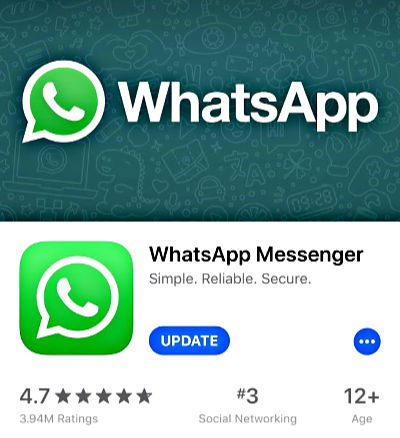
It really is.
And WhatsApp is one more reason to get a smartphone. That is if you are someone still stubbornly holding out on getting one.
Find out about your cell phone options in Panama
WhatsApp is a messaging app that allows you to send and receive:
Free, But Need Internet
In order to use WhatsApp, you do need wifi or data on your phone, but otherwise, it is free.
And it is not limited to your phone. You can use WhatsApp on your computer too.
Encrypted & Secure
Also, WhatsApp uses end-to-end encryption so your communications are secure. Not even WhatsApp's employees can read the messages that are sent across its network.
In Panama, it is common to see WhatsApp contact numbers everywhere from business cards to advertising campaigns. People not only use it to message their friends, but also doctors, lawyers, plumbers, and maids.
In the US, a common expression is "Google it". In Panama, it's “Mandeme un WhatsApp”, the Panamanian equivalent of "give me a call".
WhatsApp groups are another good reason to use the app. WhatApp groups are very popular.
For instance, my neighborhood in Panama has one. There are also WhatsApp groups for expats in my town of Puerto Armuelles (and in most towns). It is a great resource to get questions answered, to announce get-togethers, to ask for help, and more.
A Tip: Make sure you turn off the auto download setting. If you don't, all the images shared via these groups will automatically be saved to your camera roll. You can still save the ones you want.
Voice Messaging
Voice messaging is a very popular way to communicate via Whatsapp. You will often see people with their phones in front of their face, talking into the phone. They are sending voice messages.
Myself, I much prefer the voice to text function - for both sending and receiving. I'd rather read a message at a glance, esp since you cannot listen to voice messages just anywhere, at least not without headphones. Although, it is nice to hear a person's voice sometimes.
WhatsApp is not only popular in Panama, but in most of the world. Its initial attraction was due to SMS text fees.
In the US, texting usually is unlimited and is packaged with your cell phone service plan. But in many other places, the fee for texting is an issue. Which is where Whatapp's free service steps in.
Since it started in 2009, WhatsApp has become the primary social network in many countries, including Panama, Brazil, India, and in large parts of Europe.
It is so popular that you will often see advertisements from local cell phone carriers offering free data for WhatsApp use. It undermines their own texting services, but it entices people to chose their company for data.
You know it is a WhatsApp number if it starts with a plus sign (+).
A WhatsApp number follows this format:
+ then country code then cell phone number.
About Phone Numbers in Panama: There are no area codes in Panama. Cell phone numbers in Panama are 8 digits long and always start with a 6. Landlines are 7 digits long.
Here is some information that is helpful to know before you download and set up your WhatsApp app.
Your WhatsApp number will be whatever your cell phone number is at the time you download and set up the app. If you download the app in the States, it will be your US phone number.
As long as someone also has WhatsApp, they can WhatsApp your WhatsApp number regardless if they are in the US, Panama, or Egypt - for free.
How To Change Your WhatsApp Number
If you want, you can easily change your number on WhatsApp. For instance, say you put a new SIM card into your phone when you get to Panama. You can choose to make that your WhatsApp number, not your US number.
To change your WhatsApp number, simply open WhatsApp, click settings, then Account. You will then see an option to "change number". Follow the simple instructions.
It is easy and has no repercussions.
You do not need to notify all your contacts to let them know you changed your number. It is seamlessly done. They can continue to contact you at your US WhatsApp number and you will receive it. They never need to know you changed it. Your text threads will remain unchanged. (However, if they have never Whatsapped you on your old number, I believe they need to use your new number to successfully contact you.)
No Need To Change Your WhatsApp Number
The wonderful thing is that you can still use your original WhatsApp number, even if your cell phone number subsequently changes.
I switch SIM cards when I go to the States and again when I go back to Panama. This means that although my phone number changes, my WhatsApp number stays the same regardless of which country I am in. Unless I decide to manually change it, as I explain how to do above.
Whether you are traveling or moving to Panama, it is a good idea to come armed with WhatsApp on your phone. Download it today.
And, just as important, ask your friends and family back "home" to download it too. That way, you can continue to communicate with them via your phone. It will almost be like you are still there. Well, except that you will be in a tropical paradise, and they won't.
In future posts, I will discuss other essential apps to have in Panama
Don't forget to read about your cell phone options in Panama.
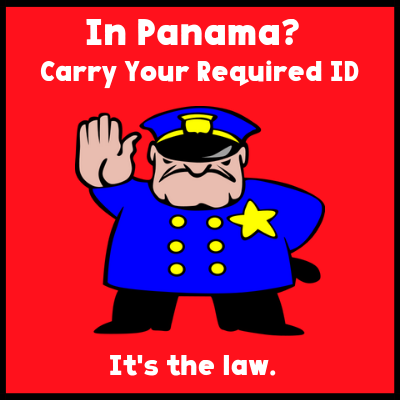
You must carry 1 of these 2 types of identification:
And only those documents are acceptable.
The government wants to make sure you are in Panama legally.
Either of those 2 documents above will allow them to discover that.
Your Costco card or your US Drivers license won't cut it.
If you don't want to carry your passport around, you can carry a copy of your passport.
You only need to copy 2 pages:
The copies can be black and white or color. We think the color copies look better, more official, but we have successfully used black and white copies as well.
Occasionally, a checkpoint official may balk at accepting a copy of your passport. You can be confident that it is legal. If you respond with confidence and possibly talking with a supervisor, you will be fine.
Before we had our residency visas, we carried copies of our passports for years. We only had to resort to talking with a supervisor about the legitimacy of our copies once. The issue was quickly resolved, and we were able to proceed.
Driving in Panama? Carry Your License. While driving a vehicle in Panama, you are required to carry your driver's license. If you are a tourist, you need to have your driver's license from home. If you are a Panama resident, you need to carry your Panamanian driver's license. (Note: the law requires that you obtain your Panamanian driver's license within 90 days from the date your permanent residency visa is approved.) Find out about driving in Panama.
In Panama, the police can stop you at any time, for any reason, and ask you to show your ID. They do not need to prove probable cause or have any cause whatsoever.
If you don't have proper ID on you, you could end up in jail. And a Panamanian jail is really not a place you want to be.
Okay, going to jail is an extreme response. But it could happen. And I know of one case in which it did happen.
Twice an official has asked for my ID, and I had no ID on me.
I did NOT go to jail. Not even close.
Once they simply chided me and allowed me to proceed on my way. The other time I had to turn around and go home. So no big deal.
However, someone I know was sent to jail.
It happened late at night, outside a bar. He had been drinking and, according to others who were there, "acting out". I was also told that he was somewhat obnoxious about being asked for ID.
However, he was allowed to call a friend, who brought his ID to the station. He was promptly released.
(I strongly recommend you resist any temptation you may have to bribe your way out of a situation. That method doesn't lead to anything good in the long-term.)
There has been a growing anti-immigration sentiment in Panama, accompanied by occasionally stricter enforcement at checkpoints.
Keep in mind, the anti-immigration feelings are mostly focussed on Vensulians and other central and South Americans who are here working illegally. Regardless, it is better to be safe than sorry.
Carrying your ID is a pretty easy rule to follow. Plus it makes taking spontaneous road trips possible! ( I love spontaneous trips.)
For instance, a few times we suddenly decided to go to Boquete, unfortunately, we had to turn back because we realized that one or more of us didn't have our ID on us.
We live near Costa Rica, so to go most places we have to pass by a major border crossing - coming and going.
Our nearby Pasa Canoas border area is also a great shopping destination, so the hassle is generally worth it. (FYI - We live in the charming beach town of Puerto Armuelles, Panama.)
Make your time in Panama both legal and filled with potential spontaneous fun. Always carry your ID.
Enjoy monthly info on life in Panama. Sign up for our Living in Panama Newsletter.
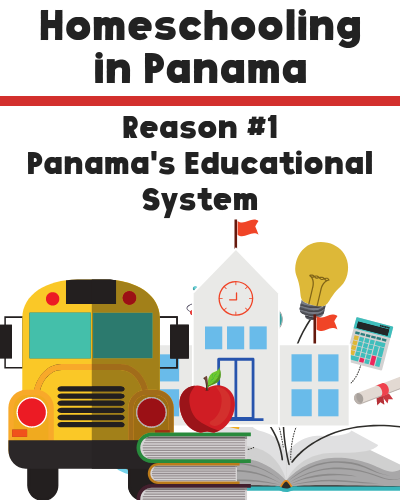
I had never even considered it as an option. Moving to Panama changed that.
Many expat families in Panama homeschool. Some of those, like me, had had no plan to homeschool before moving to Panama.
Deciding to homeschool can be scary. It feels like a lot to be responsible for your kid's education on top of everything else. I have since become pretty passionate about the benefits of homeschooling, but acknowledge it is not the right choice for everyone.
For a long time, I have wanted to share what I have learned about homeschooling in Panama. However, to be honest, I have been too busy with life and homeschooling our 2 daughters to tackle this large and complex topic.
2 recent events have prodded me to finally share my homeschooling experience and knowledge
As I look at all my notes for this article, I can already see that this topic will be better broken up into several articles. I will cover many topics in those homeschool articles, such as:
I will just start with the most obvious one: Why homeschool in Panama.
I am not going to go into all the reasons to homeschool wherever you are in the world, not just in Panama. Although, I will share a TED Talk video below which I find conveys a very compelling pro-homeschool argument, no matter where you live.
[leadplayer_vid id="5BB17319133C3"]
In this post, I focus on how the education offered in Panama is a reason to homeschool.
Many expats, and increasingly locals (esp. in Panama City) decide to homeschool because most schools in Panama are terrible.
Not all schools, but most.
At that 1st ever homeschooling conference, I asked a Panamanian mother who has lived in Massachusetts and Panama City about schools in Panama. I specifically asked whether she thought the expensive private school in Panama City were good schools. She replies that she was not impressed with the expensive private schools in Panama City. She homeschools.
However, I think these private schools are still a far superior option than other available local schools. Unfortunately, these schools very expensive and there are only available in a few areas in Panama. Most of them are located in Panama City, although there is one in David, One in Boquete and a few others elsewhere in Panama. A Google search will uncover many of them for you.
Panama's Almost-Last Place In Global Ranking
It is not just my opinion about schools in Panama. The last time Panama permitted its students to take the PISA test and get ranked against other students in the world, the results were dismal. The PISA test is taken by 15 years olds in countries around the world to assess their skills and knowledge. The intent is to help lower-income countries improve their educational system.
In 2009, Panama education was ranked 3rd from the bottom in the world. The only countries that ranked lower than Panama were Peru, Azerbaijan, and Kyrgyzstan. "The knowledge of a 15-year-old student in Panama is equivalent to that of a 12-year-old student in other OECD countries. Panama has a three-year delay in schooling," said Sebastián Grandchild.
(OECD stands for Organization for Economic Co-operation and Development, which is the parent organization for PISA. Check out this PISA link).
Since it's embarrassing 2009 ranking, Panama refused to be part of PISA test in 2012 and 2015.
Hope for the Future? New Rankings Soon
However, the new head of Education in Panama welcomed the testing this year (2018). The results are not in yet.
Importantly, Panama also participated in PISA's capacity needs analysis. The 2018 conclusion is that MEDUCA (Panama's education department) is severely lacking in staff, esp. staff trained in assessment. In addition, they found that Panama has no effective school assessment plan or tool. On the plus side, PISA says that Panama has the resources and the apparent will to create one and to improve its schools.
Crossing my fingers. Because, although there is a lot of government talk about the need to improve schools in Panama, not much has changed in the classroom. There has been a push & funds for more technology in the classroom. But the curriculum remains humanities-centric vs STEM-based, and there is a lot of pushback from the unions about changing the system. And of course, Panama's oligarchy-leaning system is not over-eager to better educate it's poor.
One reason Panama's schools are so bad is the typical teaching methods. Many schools emphasize rote memorization.
Also, teachers tend to value their students repeating the correct answer over developing problem-solving skills or deepening their understanding of a topic.
To give an example, schools are required to teach at least one class in English. I have had kids, one who is in a supposed English immersion school, read to me from their English books. They did great, although with some pronunciation issues. But when I asked them, what they read they could not tell me. They could read in English, but they did not understand it. Maybe they teach English comprehensive later, but I have been surprised by the lack of understanding from elementary school children.
Also, an amazing amount of classroom time is spent on copying. First, the student watches their teacher write a lesson on the blackboard. Then the child will spend even more time copying what the teacher wrote down into one of the many single subject notebooks they are required to use.
My younger daughter particularly hated the copying. She simply could not keep up with the kids who have been copying - and only cursive is allowed - for years. Plus she didn't even understand what she was copying down.
The same is typically done for homework assignments. Instead of distributing printouts of lessons or homework, the children have to copy them down. And they are graded on their penmanship - all in cursive. This doesn't leave a lot of time covering material or for questions. In fact, in our experience in Panama's schools asking too many questions is not encouraged.
Plus, there is an inordinate amount of busywork for homework. Cutting, pasting, and coloring feature strongly in the homework of elementary students. They even sell books to use to easily accomplish the required cutting and pasting homework. Before I discovered those books, I spent much time looking the required image in magazines or online to print so my daughter could accomplish her mindless homework assignment.
If you send your children to school, they can still learn and keep their love of learning alive. But it will take some participation by you. Perhaps they need some supplemental learning opportunities, or simply an open, "we love learning" attitude expressed at home to counteract the dullness they may experience at school. Thankfully, Panama's school typical schedule of ~7 am to 1 pm, this makes it easier to find time to do any needed supplemental learning.
Going to school in Panama does have strong advantages for expat kids, which I explore in a future article.
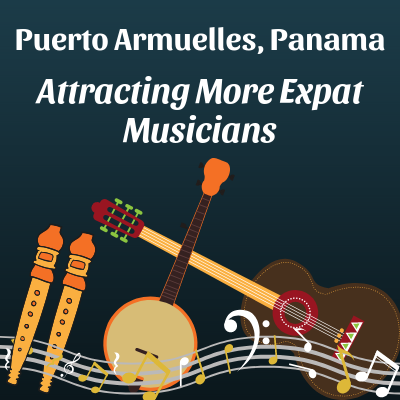
Over the past several years, I have noticed a steady stream of expat musicians arriving in Puerto Armuelles. I am not exaggerating when I say that I have met at least 6 new expat musicians who have moved here in the past year or two. No doubt there are others whom I have not met.
One expat musician, as you will see below, is offering to teach adults the recorder.
In the Corazon de Jesus neighborhood, there are 2 really good guitar players who live side-by-side in remodeled Panamanian concrete block houses. This is of particular interest to me since I have taken up the guitar as my “old guy hobby”.
Just this past week, I spoke on the phone with a couple who are curious about venues for performing their music in Puerto. They will be visiting Puerto for the first time soon.
So far, we have not had any sort of “open mic” nights in Puerto like the ones in Volcan or Boquete. However, with the arrival of so many musicians here perhaps a regular open mic event could be organized.
I know that Heavenly’s Hotel (Now Big Daddy’s) did have a few musical performances by local expat musicians. However, such events were not regularly scheduled. I will talk to Dave, one of the owners of Big Daddy’s Hotel, to see if anyone has expressed interest in performing lately. Hopefully, Big Daddy’s would welcome such a regular event. Come to think of it, Dave plays the drums. He doesn’t perform, but he loves music.
In Puerto’s Coronado neighborhood there is a family of musicians, Melinda, Ingrid, and Melinda’s son Ramy. They all play guitar. However, Melinda’s passion is the banjo. Not surprisingly, Melinda, in particular, is very enthusiastic and knowledgeable about bluegrass music.
Some very good news is that Ingrid is offering recorder lessons for interested adults. She is a retired music teacher from Anchorage, Alaska. As I mentioned above, Ingrid also plays guitar.
The recorder is a great instrument for learning the basics of music. And you can take it as far as you want to go. Ingrid has brought a number of alto recorders with her to Puerto so that she can assist those who want to give it a try.
(FYI, a basic recorder is easily purchased in Panama since the recorder is taught to most students sometime during elementary school.)
With luck, maybe she can even get a little recorder ensemble together. That sounds like fun.
If you are interested in lessons, contact Ingrid Lindberg of Puerto Armuelles via Facebook.
I'd be interested in taking up the recorder again. Many years ago, my brother and sister-in-law, both musicians, gave our family an assortment of recorders. We brought them down to Puerto over a decade ago, hoping we would starting playing the recorder. But it never really interested our kids nor my wife. (I had played a recorder for a couple of years as a child. I can’t have forgotten it all, I hope.).
I am going to dig through our various boxes of “stuff” and find those recorders. Then, I am going to get in touch with Ingrid to start re-learning the recorder. My attitude is that it is never too late to start to play music.
If you are a musician, or if you are interested in getting started playing music, please let us know. We'd be happy to steer you to others in Puerto who share your passion.
Thanks for reading, Reyn
Interested in Creating Art?
Check out more happiness-enhancing hobby suggestions
It pleases me to be able to repeat what I said 3 years ago
“No. There are still no hurricanes in Panama”.
In fact, there has never been a recorded landfall of a hurricane on the isthmus of Panama, Central America.
However, back in 1969, Hurricane Martha, with winds up to 90mph, was sighted 100 miles off the Atlantic coast of the Veraguas Province of Panama.
This category 1 (1 is the weakest, 5 is the strongest) hurricane weakened to a “tropical storm” with winds below 50mph before it finally made landfall in a rural part of Veraguas and quickly died out. There was no significant impact on the human population.
That’s about it, as far as hurricane activity in Panama is concerned.
As for more current weather events, on a Tuesday in August of this year (2018), we experienced high winds in Puerto Armuelles. That night wind gusts of 30-35 miles per hour toppled trees around Puerto Armuelles and caused residents to be without electricity. Most areas only lost electricity overnight, a few areas were without power for a day or two, and in the beach neighborhoods of Corazon de Jesus and further out for a few days.
We had to hire a neighbor with a chainsaw for a couple of hours the following day, to remove one fallen tree from the roadway into Corazon de Oro. That was the extent of the damage to our property. This windstorm encouraged me to have some preventative pruning done to other trees, which were overgrown, or posed a risk to power lines or fences.
Some areas of Panama are prone to heavy tropical rains during the rainy season. Generally, these do not affect normal human activities. However, in places like Panama City, where rapid development has outpaced the municipal infrastructure, flooding can be problematic from time to time. We have never seen this first hand, we have only read about it in the paper.
In the Chiriqui Province, there are places with heavy rains, and on rare occasions, there may be a temporary road closure due to flooding. On one particularly stormy November night about 6 years ago, we were driving from David to Panaso Canoas in knee-high in water. The flooding occurred due to the culverts being clogged by a recent mowing of nearby vegetation. That night, soon after we crossed it, a bridge went out. No one was hurt.
One of the most dangerous places on earth for Hurricanes continues to be the southern and eastern coasts of the United States. The “Sunshine State” of Florida is one of the worst for Hurricanes. It is the worst on all counts: frequency, strength, duration, and damage to property.
As I've said, Panama City, Panama (and all of Panama) has never had a Hurricane. Meanwhile, it's namesake, Panama City, Florida, has the nickname "Hurricane City". Panama City, Florida has had a constant barrage of Hurricanes and tropical storms batter its beaches over the years.
In fact, since records of hurricane activity have been kept beginning in 1871, Panama City, Florida has been hit by 60 hurricanes or major tropical storms. That is a major weather event every 2.43 years, with a Hurricane every 8 years. The next predicted hurricane in Panama City, Florida is expected within this very hurricane season, which ends this month. That is too much hurricane activity for me, but I am a bit of a worrier.
If you were to look at a map of major Hurricane activity in this hemisphere, the map would look like a map of the southeastern United States. To be precise, Florida, Louisiana Mississippi, Georgia, Texas, North and South Carolina, Virginia, Maryland, Delaware, New Jersey, New York, etc all the way up to Maine. All of these areas are far more vulnerable to hurricanes than the Republic of Panama.
Thanks for reading.
Reyn
Get news on living in Panama. Sign up for our monthly newsletter today.
Updated May 5, 2018
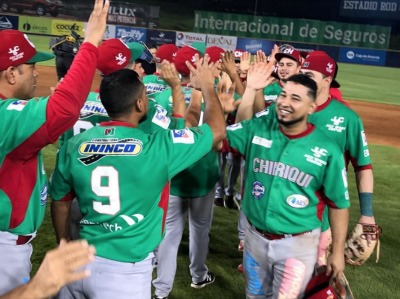
Its happening April 27-29, 2018
Sadly, our team Chiriqui Occidental (of Puerto Armuelles) didn't make into the final series, but Chiriqui (of David) did.
Chiriqui is battling it out with Bocas Del Toro. The team who wins 4 out of 7 games is crowned champion.
After 4 games it was 2 and 2! But in the end, Chiriqui lost the championship to Bocas del Toro.
Chiriqui really wants to win this championship. They were the champions in 2016.
Then Colon beat Chiriqui to win last year's championship. But I must say Colon deserved the win. It was the first time in 54 years that Colon won the championship.
Regardless, Chiriqui wanted the title of champion back in 2018.
Chiricanos (people from Chiriqui) are very proud of their province. And they have many reasons to be proud. One being baseball.
Chiricanos are very very good at baseball. You won't make any friends rooting for a rival team.
Carlos Ruiz - Major Leaguer
In fact, one of David's prodigal sons, Carlos Ruiz, played in these 75th Championship games. Ruiz is a catcher in US Major League Baseball. He started with the Phillies, then went to play for the Dodgers, then the Mariners, and is now a free agent.
Ruiz is the only player in the history of the National League to catch four no-hitters, and 1 of only 2 catchers in Major League Baseball, the other being Jason Varitek. (source: Wikipedia).
Baseball in Panama has two leagues, Juvenile League and the Panamanian Major League (AKA Panama Baseball League).
Each of Panama's 10 provinces has its own Juvenile and Major League baseball teams. However, Chiriqui is so good at baseball it can field 2 teams: Chiriqui Occidental (Puerto Armuelles) and Chiriqui Oeste (David).
Not even the Panama province has 2 baseball teams and it is hands down the most populous province in the country. (FYI- The province of Panama's team is called Panama Metro.)
In the Major League, the Panama Metro team wins many championships, Herrera is often a contender, and Chirqui continues to hold its own.
The 11 teams are: Bocas de Toro, Chiriqui, Chiriqui Occidente, Colon, Cocle, Darién, Herrera, Los Santos, Panama Metro, Panama West, and Veraguas.
Well, actually, 22 teams if you count both the Juvenile and Major league teams. And they both should be counted. Panama takes its juvenile league very seriously.
TIP: One quick way to start a friendship with a local Chiricano is to ask about their baseball team.
As it turns out, baseball was not introduced to Panama by the Americans who came to build the canal. It started well before then. Baseball has been played in Panama as far back as 1883 when Panama was still a province of Colombia.
On Jan. 9, 1883, Panama’s Daily Star and Herald described a baseball game played in Chiriqui Plaza 2 days before. It was between a team from Chiriqui Province and members of the Panama Cricket and Baseball Club. (See Chiricanos have had a very long love affair with baseball). The Cricket and Baseball Club won. That team was mostly made up of West Indian workers brought in during the failed French-managed canal construction.
However, Panama's baseball history may go back even further. Back to a time before Amerca had even standardized rules for baseball. In his book, Historia del Béisbol Panameño, the Panamanian historian Ramon G. Pérez Medina writes that the 1st baseball game was played in Panama in the mid-1850s. One team was made up of American traders and the other team was men affiliated with the Panama Railroad Company.
In 1945, the Panamanian Major League was created. As I mentioned, the league has 11 teams: Bocas del Toro, Chiriqui, Chiriqui Occidente, Colon, Cocle, Darién, Herrera, Los Santos, Panama Metro, Panama West, and Veraguas
The first Panamanian to join an American Major League Baseball team was pitcher Humberto Robinson, who debuted with the Milwaukee Braves on April 20, 1955. Including the 4 major leaguers who were born in the Canal Zone, Panama has sent more than 50 players to the U.S. majors. That total includes recent players: Ruben Tejada, Christian Betancourt, Randall Delgado, and Carlos Ruiz.
Find out about the 10 Best Panamanian Players in MLB History, here.
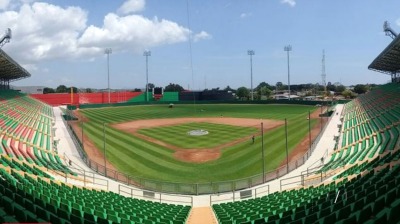
The Kenny Serracin Stadium in David, Panama is brand new.
It had its first game on March 23, 2018. And Chiriqui won!
(David is the capital of the Chiriqui Province)
Chiriqui was playing against one of their top rivals Herrera. Huge celebrations ensued!
The stadium has seats for 8500 fans. The old stadium only accommodated 2000 people.
It is all tricked out with lights and modern boxes. It was built to comply with the requirements of a Major League stadium in the States.
Where is it?
It is easy to find. It is pretty big.
It is by the intersection of the Interamericana and the overpass of the new road to Boquete. Another way to think about it, is that it is close to the Super Baru, the supermarket. Or better yet, punch the address into WAZE.
The Address
Calle P Norte (e / Av. Obaldía and Vía Belisario Porras)
David ,Chiriquí
About Kenny Serracin - the Man
Kenny Serracin is from Puerto Armuelles! (which is where we live in Panama). That is where he learned to play baseball. He also worked picking bananas in the banana plantations near Puerto Armuelles. Mr. Serracin later moved to David, where taught PE at a school in Doleguita. He then worked as the administrator and sports director of the original baseball stadium.
All the while he continued to play baseball. He was playing for Chiriqui when it won its first championship in 1944.
He was a man who worked for the love of the game.
In the 1970s, after he stopped playing ball, Mr. Serracin worked with the Lions Club to form little leagues teams and he helped to reorganize baseball throughout the province.
Updated: July 28, 2019

My screen was a mass of colorful lines in motion.
Very pretty. But useless as a phone.
I felt disconnected from the world.
Cell phones are the easiest way to connect with friends and family - no matter where you are.
For people newly transplanted to Panama, having that connection is very important. It will help you feel less lonely and alone as you find your place in your new country.
I strongly recommend that you figure out your phone situation before you move to Panama.
An aside: When my iphone died (above), I bought a refurbished one off ebay and had it sent to me in Puerto Armuelles. Shipping to Panama cost only $13! I used Hot Express. Find out more about getting products mailed to Panama.
Your 1st step is to decide on the cell phone you will use in Panama. If you use your current phone, know that paying your plan's expensive international roaming charges is not your only option.
Luckily, it is easy to avoid paying those high roaming charges.
You have 3 options to avoid paying international roaming charges while in Panama.
This is a good option. Having an unlocked phone allows you to buy a SIM card from the provider of your choice and start using their service.
One of the main advantages of using your current (and unlocked) phone while in Panama is you will have access to all your contacts and other information that you store on your phone. This makes life a lot easier.
What is an unlocked phone? If you signed a 2-year contract to get a cheaper phone, it’s probably locked. Which means it will only work with your current service provider. However, most phone plans these days don’t require a contract. When you have an unlocked phone you are free to use any service provider.
Some background info: A SIM card is the little chip your service provider gives you. It is inserted into your phone and determines your phone number. You need a new SIM card whenever you change service providers.
Thankfully, the SIM card is independent of your phone storage. Changing your SIM card does not affect any of your contacts, photos, apps and other information you have stored on your phone. Which is why unlocking your phone is the best option. You can keep all your info, even as you change to a new provider in Panama.
Keep in mind, to use a SIM card, your phone must use GSM technology. Your phone probably uses GSM. Most phones in the world do. There are some phones in the US that do not. They use CDMA technology. For example, Verison, Sprint, and US Cellular have CDMA phones. But these companies have been switching to GSM or Universal phones. Universal phones accommodate both technologies.
The best way to get an unlocked phone is to get your current phone unlocked, if it isn't already.
It is easy to unlock your phone.
For instance, back in 2015, the USA passed a law requiring providers to unlock customers' phones upon their request. However, the company is only required to do so if you don't owe money on your contract or phone.
1. Call your provider. Don't go to your nearest cell phone store and ask them to unlock your phone. They most likely won't be able to help you. You need to call the 1-800 number for your service provider. Explain to them that you need it unlocked so you can use a local SIM card in Panama. Don’t let them talk you into signing up for their international roaming plan. Those are almost never a good deal. Once they do their part of the unlocking process, they will give you a code or a few things to enter into your phone for the unlock to take effect.
2. Online unlocking services. There are plenty of services available online that will unlock your phone. For instance, ebay features a few. Check their reviews to choose a good one.
3. Unlock in Panama. Most locations have someone who can unlock your phone. However, I'd recommend getting it done before you come to Panama.
We always buy unlocked phones. We usually buy them refurbished on eBay. It is my favorite way.
You can also buy an unlocked smartphone in Panama. One option in Panama is to buy an Android smartphone that takes 2 SIM cards. The dual SIM card option enables you to use 2 different Panama service providers. If you don't have coverage with one provider, you could switch to your other SIM card provider. (Maybe you can do this in the States as well. I don't know. So far, I have only used iPhones.)
Please buy a smartphone.
Not a simple phone that can only call and text.
People in Panama do not text, they Whatsapp.
Whatsapp is a messaging app only available on smartphones. Find out about Whatsapp here.
Sending a normal text in Panama is expensive because unlimited texting plans do not exist. Which is why everyone communicates with messaging apps - esp. Whatsapp - that use data plans.
You really should download Whatsapp before you come to Panama.
If you use Tmobile, then you don't have to make any changes to your phone or phone service at all. You can just continue to use your phone with your TMobile service.
TMobile offers unlimited texting and data (3g only) in Panama (and in over 210 other countries). The data service can be slow in Panama since they do throttle the data. TMobile says they don't throttle data in the US, but I cannot confirm that.
(Note: TMobile usually has a cheaper plan for people age 55 or older. Something to check out.)
TMobile also charges a somewhat reasonable rate for phone calls made while in Panama: $0.25 a minute. However, a better choice is to use WhatsApp, or other wifi based call app, for your calls and then you can avoid those roaming charges.
(Below, I list other free or inexpensive video and calling methods you can use to keep in touch with family and friends back home.)
You pay the same amount for your TMobile service whether you are in Panama or in the US. Well, except for any phone calls you make while overseas.
However, if fast Internet on your phone is important to you, you should get an unlocked phone and a local service provider. Your data speed with TMobile will be fine for texting and calls, but you won't be able to stream or do other high-load activities.
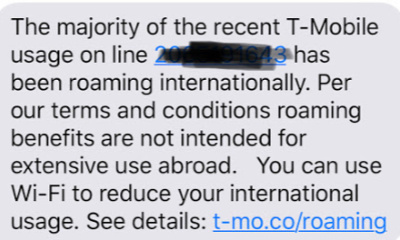
Another point against Tmobile: It does not like its customers to use data overseas on a long term basis. If you use Tmobile as your provider while living in Panama, they will continually remind you should not do that. (See the photo)
Tmobile states that using over 50% of your voice or data off-network (as in use in Panama) for an extended period of time is a violation of its Terms and Conditions. They also state that if you are in continual violation it will affect your service.
Once you have your phone choice all settled, you need to decide which service to use. As I mentioned, using the international roaming option with your current provider is usually an expensive option. Unless you use TMobile, and that has its limitations, as I discuss above.
Local Service Providers
Movistar, MasMovil, Claro, Digicel, Cable & Wireless are some of your service options.
How well a cell service works in Panama depends upon your location. You should ask people in your area of Panama about which provider works the best there.
You can easily switch providers if it doesn't work out. It will only cost a $3 SIM card. Make sure to ask your new provider to port your number to their service.
How To Use A Local Provider
Panama's Main Cell Service Providers
Our Opinion
Personally, we like Movistar the best. One of the biggest pluses for me is that its data seems to be faster and more available than MasMovil. Most people I talk to agree with my assessment. Keep in mind, I have never used Claro or Digicel, only MasMovil and Movistar.
You can buy minutes and Internet as you need them via pre-paid cards or by signing up for a monthly plan. Your choice will depend upon your needs and preferences.
You can buy minutes as you need them. You simply buy a prepaid card. You can buy these cards at grocery and other stores.
Ask for a "tarjeta de (your provider)". Tarjeta means card.
The cashier will ask you what value you want on your card. I have the best luck using $5 cards. I don't know why, but often when I try to input a card with a higher value I have more difficulties. You may not find that true.
Instructions for inputting your minutes are on the back of the card. The instructions are in Spanish. It is very simple.
Listen to the recorded message that plays right after you hit "send". It will be in Spanish. But if you hear the value you input, "cinco balboas" for $5, that means it worked. If it didn't, do it again. It will probably work the on the 2nd try. It usually does.
You can input a new card into your phone when you run out of minutes or you can recharge your phone online. Your provider will most likely text you instruction on how to add more minutes to your phone online. If not, you can ask someone, or look on your provider's website.
Minutes Expire
Once you input the minutes into your phone you have 2 months to use them. Any remaining minutes will expire.
However, the clock does not start running until you input the minutes into your phone. It is good idea to have an extra card on hand for when you unexpectedly run out of minutes, or when you re-enter Panama after some time away.
Internet - Pay As You Go
You can also use these prepaid cards to input data on your phone. It is not the best method if you are going to need data on a regular basis, but it works for your short-term needs.
Technically, you can automatically use your minutes for talking or internet use, but I find it works better if I explicitly ask for the data. Plus, it means you will save that value for internet alone, and it won't be used up by a phone call.
Typically, after you input your minutes, your provider will send you a text telling you how to convert those minutes into data. But not always. Here is what you do.
After hitting send, you’ll be guided through an on-screen setup process asking what you want to buy and how much of it you want. It is all in Spanish, but it is easy to figure out. Basically, you want to respond that you want a "paquete de datos" and yes, you want to buy ("comprar") whichever packet of data you selected.
All the providers offer a monthly data/talk/text plan.
The price depends upon the amount of data. No provider offers unlimited data plans.
Visit their offices or websites to get more information on what each plan offers. You can only start your plan in person, by visiting one of your provider's service stores.
My Local Monthly Plan
I have a monthly plan with Movistar that costs me $17 a month. They have less expensive and more expensive plans than mine.
To set up my plan, I needed to visit an official Movistar office in person. It was easy to do and the gentleman who helped me spoke English well.
I have never used my online Movistar account. The only thing I can use it for is to change my plan. I cannot start or stop my plan online.
No Contracts
Typically there are no long-term contracts (or any contracts) required for service plans in Panama. They are all monthly plans that you can cancel at any time.
But you cannot cancel your plan online. At least not with Movistar. You will be told that you must visit the office, in person, to cancel your plan. However, most companies, also have the option to text in an order to stop. They will not volunteer this information usually, you must ask.
So make sure to ask what to text to cancel your service. This is a good thing to know if you will be leaving the country for a month or more. Otherwise, you will be paying for Internet even when you are not in the country. Of course, even that it a pretty reasonable cost, (mine is $17/m0, Reyn's is $7/mo), it isn't much of a hardship.
Some local providers & your "home" provider offer international calling plans. However, before you spring for one of those, keep in mind there are many free ways to call internationally using wifi or by putting data on your phone.
Below are 5 options easy ways to keep in touch with friends and family back "home".
You can even buy an international calling card, available at most of the same places that the prepaid cards are sold. You buy a specific number of minutes and follow the directions on the card to use it to call internationally.
I'd recommend setting up all 5 of them. They are each useful in different situations. Plus, various people in your life will prefer one over the other.
It is pretty easy to set up a cell phone in Panama. If your first provider doesn't work out, it is pretty easy to switch. A SIM card only costs about $3.
Your whole communication set up will work better if you have a smartphone.
At this point, if you have somehow avoided buying a smartphone, congratulations. That is quite the accomplishment. But you might want to make the leap before you move to Panama. Having a smartphone will make communicating both with people in Panama and back home much easier.
For instance, almost everyone in Panama uses Whatsapp to both call and text. It is a great app. If your friends and family back home don't have it yet, encourage them to get it. It will allow you to communicate with them for free, if you both have the app. It really is a wonderful app. Find out about Whatsapp here.
And there are just so many other apps you can get to improve your communication as well as your entertainment. I will discuss those in a future post.
In Puerto Armuelles and have a cell phone problem? Maybe you cannot download an app, get data on your phone, or it keeps freezing, or whatever. Check out Genius Place, a cell phone & technology store. They may be able to help you out.
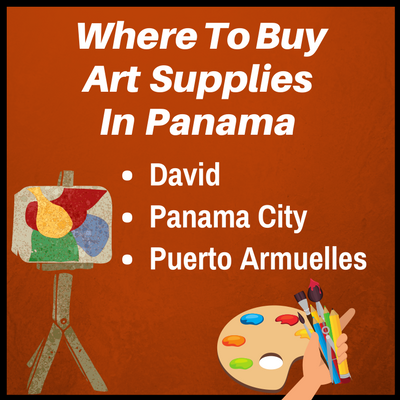
You can find craft and art supplies at many stores in Panama. However it isn't necessarily of the best quality, especially the paints. Although, Panama City does have stores which sell higher quality paints and other supplies.
You can also order higher quality supplies online and get them shipped to you in Panama. Check out this link on getting online purchases delivered to Panama.
Painting Canvases
Before I list the places where you can buy art supplies, I wanted to say a word about canvases for acrylic paintings. You can buy pre-made canvases at many of the stores listed below. However, you can also easily make your own.
To make your own painting canvas, the fabric to use is called manta sucia. It is a very affordable light cotton duck fabric. It is available at any fabric store. You can make the frame yourself or have it made at any woodworking shop. Then stretch the fabric onto it using staples.
This is not a comprehensive list of all the places you can buy art supplies. However, it includes some of your better options.
More Resources in Puerto Armuelles
Learn about art classes, workshops and more available in Puerto Armuelles.
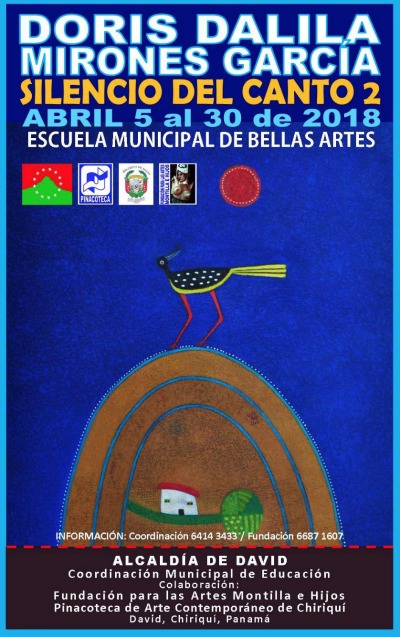
More Resources in David
Pictured is the poster for an upcoming show. It opens an April 5 and closes April 30, 2018 The show is co-sponsored in part by the Fundacion para las Artes Montilla e Hijos and Pinacoteca de Arte Contemporaneo de Chiriqui. Both are Chiriqui focused art organizations. Call 6687-1607 for more information or to learn of up coming shows.
More Resources in Panama City
Master net is a craft/art store with classes. You can find out more on their facebook page: facebook.com/masternetpty It is located in El Carmen, calle del Teatro En Circulo, next to ScubaPanama. +507 261-8995/
Panama City has a Museum of Contemporary Art. For more info, check out their website: macpanama.org.
Please contact us or leave in the comments your favorite art supply stores, art museums and galleries, or other art resources in Panama.